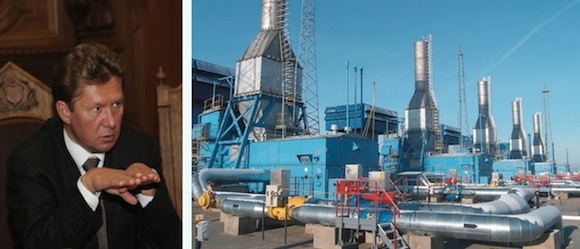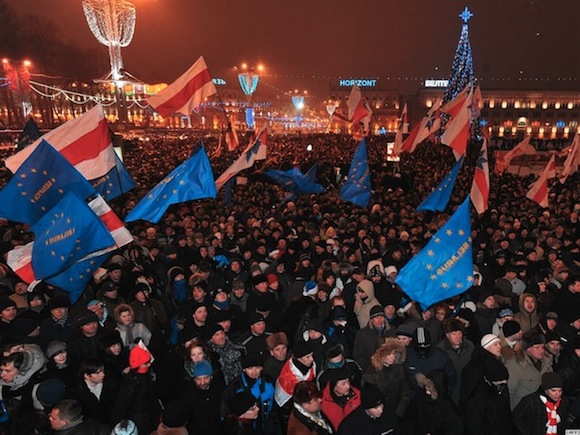Belarusian Transit
Since 1992, there has not been any large-scale privatization of Belarus’ largest industrial companies (Belneftekhim, Belenergo, Beltransgaz) that together provide up to 75% of the country’s GDP. Two trunk pipelines owned by major Russian entities run through the territory of Belarus: the Yamal–Europe gas pipeline (owned by Gazprom) with an annual capacity of 30 billion cubic meters of gas, and a northern branch of the Druzhba (Friendship) oil pipeline (owned by Transneft) with a capacity of 49.8 million tons of oil.

Gas wars between Minsk and Moscow lasted for more than ten years. But in the end of 2011, Gazprom's CEO Alexei Miller (left) could finally declare victory after buying out the second 50% share of Beltransgaz, the largest energy company in Belarus.
Largely due to the fact that Russian had been selling its energy resources to Belarus at the low Russian domestic prices, the latter had a booming economy. In 2004-06, Belarus’ economy grew at an annual rate of 10% and the average salary in the country grew by 80%. In 2005, the situation started to change gradually.
Soon after Vladimir Putin came into power, he changed the management of the country’s gas monopoly, Gazprom. The new team sought to end the special pricing granted to Belarus, an “offshore” customer, that had been so beneficial to Lukashenko. In 2002, the Russian gas monopoly offered to sell gas to Belarus at the low price of $29 per a thousand cubic meters in return for Belarus agreeing to create a joint enterprise on the basis of Beltransgaz, the Belarus gas pipeline company. Gazprom estimated the company price at $600 million, while Minsk set the price at $5 billion. As a result, the idea of a joint enterprise had to be buried. In 2004, Gazprom announced that gas sold to Belarus would rise to as much as $50 per thousand cubic meters. In the course of the negotiation process, gas supplies from Moscow were suspended many times, and Lukashenko accused the Kremlin of “terrorism” on those occasions. Still, he agreed to buy gas at $46.68, but didn’t concede the Belarusian share in the gas transport system to Gazprom.
Gazprom did not give up on its attempt to take over the gas transportation through Belarus. In March 2006, Gazprom CEO Alexei Miller made a statement that starting from 2007 gas prices for Belarus would rise to the “European level”, that is $200 per thousand cubic centimeters. To compensate for the price hike, Belarusian authorities were offered $1.5–2 billion for a 50% share of Beltransgaz. In response, Lukashenko immediately announced that Beltransgaz was really worth $17 billion.
Largely due to the fact that Russian had been selling its energy resources to Belarus at the low Russian domestic prices, the latter had a booming economy.
During the negotiations, the gas price for Belarus was set at the level of $100 for a thousand cubic meters, but Lukashenko reacted by introducing unprecedented transit tariffs for Russian oil—$45 per ton. This conflict led to a full-blown crisis preventing the supply of gas from Russia to Europe as well as limiting the transit of Russian oil. After tough threats from Moscow including the threat of a full scale trade war against Minsk, Lukashenko agreed to a compromise: gas prices increased; 50% of Beltransgaz shares were sold to Gazprom for $2.5 billion; Russian oil export taxes for Belarus were decreased by a factor of 3.4.
In November, 2011 Gazprom signed an agreement to buy the remaining 50% of Beltransgaz for another $2.5 billion, and thus Russia gained full control over the gas transportation system of Belarus. In return for that concession, Lukashenko received a subsidized loan of $10 billion and low rates in gas prices—at the Russian domestic level (in 2012, the price was decreased to $164 from the 2011 price of $244). It should be noted that in 2010, Beltransgaz net losses were about $1 billion. At this time, Gazprom was building its number one energy and political pipeline—Nord Stream to run directly from Russia to Germany along the bottom of the Baltic sea. As many analysts concluded, this deal was an entirely of a political nature since in economic terms, Russia incurred serious losses.
European Push and Pull
Despite its anti-Western rhetoric and a Russian tilt in foreign policy, Lukashenko was amazingly persistent in returning to the idea of cooperation with European countries whenever his relationship with Russia suffered a setback. His idea of “cooperation” was to get loans from European banks in return for democratic reform.

In the end of 2010, ministers of foreign affairs of Poland and Germany, Radoslaw Sikorski (left) and Guido Westerwelle (right), offered Lukashenko a €3 billion loan line provided that the presidential elections in Belarus were democratic.
The pattern of relations between Belarus and European Union can be described as a “push and pull policy.” The EU, not able to abandon its dream of a Belarusian democracy, regularly seeks to establish good relations with the Belarusian president, but falls into same trap over and over again. Lukashenko constantly promises to conduct reforms, but after a temporary “thaw,” he always breaks his promises.
For example, after a long period of cooling relations, the EU, in 2003, adopted a new program of developing its relations with neighboring countries to which it invited Belarus. But the following year’s another referendum on constitutional amendments held by Lukashenko forced the EU to reconsider Belarus’ participation in the program. There followed a new period of chilled relations that coincided with Belarus economic growth that was achieved due to the low prices of Russian gas.
In 2009, the EU once again invited Belarus to take part in a European project. This time it was the Eastern Partnership under which the European Bank of Reconstruction and Development (EBRD) approved a loan of $30 million to Belarus. In 2010, the dialogue between Minsk and Brussels was developing at unheard-of speed. The German Minister of Foreign Affairs, Guido Westerwelle, and the Polish Minister of Foreign Affairs, Radoslaw Sikorski, offered Alexander Lukashenko a €3 billion loan line and political rapproachment provided that the Belarus presidential elections scheduled for December, 2010, were democratic.
The EU, not able to abandon its dream of a Belarusian democracy, falls into same trap over and over again. Lukashenko constantly promises to conduct reforms, but after a temporary “thaw,” he always breaks his promises.
Again, the dialogue with EU coincided when Lukashenko’s relations with the Kremlin were worsening, mostly, due to Russia’s introduction of the export tariffs to the oil exported to Belarus. In his election campaign, Lukashenko actively engaged anti-Russian rhetoric, blaming Russia for deterioration of Belarusian economy. The Kremlin responded with a propaganda onslaught against Lukashenko’s reputation by broadcasting a five-episode TV documentary, entitled Kryostny Batka, or Godfather. For example, the makers of the documentary claimed that Belarus owed all its economic success to Russian subsides that allegedly amounted to $52 billion. They also accused Lukashenko of sanctioning the killings of his political opponents (Gennadii Karpenko, Yuri Zakharenko, Viktor Gonchar). A curious moment came when the documentary mentioned that 10 years earlier, the Belarusian psychiatrist Dmitry Shehigelsky diagnosed Lukashenko as suffering from a mental disorder, “mosaic psychopathy.”
The presidential elections that took place on December 19, 2010, in Belarus, once again put end to the European Union’s hopes for democratic reforms in this country. Nine candidates, beside Lukashenko, took part in that election, but, according to the official report of the Central Election Commission (CEC), none of them came close to Lukashenko’s results—79.65% of the vote. The runner up, Andrei Sannikov, received only 2.43%. The voting day was marred by a mass protest demonstration in Minsk. According to various estimates, 10 to 50 thousand people rallied in the streets that day. The protest was brutally dispersed by the Belarusian police, and more than 600 people were arrested, including all opposition candidates.

The 2010 presidential elections in Belarus were marred by numerous falsifications, which resulted in the largest mass protest in Minsk in the last ten years. Nevertheless, the protest was harshly repressed by the police: more than 600 people were detained.
Many international organizations, such as the UN, EU, OSCE condemned the harsh actions of the Belarusian authorities. Belarusian participation in the Eastern Partnership was suspended. In 2011, Belarus withdrew from another program—Euronest, a parliamentary component of the Eastern Partnership. Negotiations on the loans also stopped. Once again, visa and economic sanctions were imposed on Belarus: today, 243 Belarusian citizens and 32 private companies are on a black list. Beside Lukashenko himself, the list includes a number of high profile officials, employees of the law-enforcement agencies, procurator’s office, the CEC, members of the president’s family, his friends, shareholders of the largest Belarusian companies and certain persons with business abroad.
Early in 2011, Belarus found itself in the midst of an acute economic crisis. For many years, the country had had a negative trade balance was burdened by the costs of the administrative command system. During his presidential campaign, Lukashenko promised to double salaries of the public sector employees (up to $500 a month). But his populist promises were not backed by adequate financial resources and the result was hyperinflation of 108.7% per year, which effectively reduced the average salary to $225 a month.
Early in 2011, Belarus found itself in the midst of an acute economic crisis. To win the 2010 presidential elections Lukashenko promised to double salaries to the public sector employees. His populist promises were not backed by adequate financial resources and the result was hyperinflation of 108.7% per year.
EU made one last weak attempt at reconciliation with Belarus in March 2012. Lukashenko was invited to participate in a program, entitled “Dialogue for Modernization,” which implied, among other things, release of all political prisoners. In July, Minsk called the terms of this program unacceptable and again loudly slammed the door in Europe’s face.
By that time, Lukashenko didn’t really care. In June 2011, the Anti-crisis Fund of the EurAsian Economic Community (EurAsEC) allocated to Belarus a credit line of $3 billion, which helped save the country’s economy (one of the condition of the loan was privatization of Belarusian companies worth $7.5 billion in three years, though as of now none of it has taken place). Russia waived its restrictions on imports of Belarusian goods and approved a $10 billion loan for 15 years to build a new atomic power station in Belarus; it also restructured Belarus’ debts for gas purchased in 2011. Gazprom’s purchase of Beltransgaz helped stabilize Belarusian currency.
In the final article of the series: Public compromise; Opposition Divided; New Struggle; The Decline of Dictatorship

